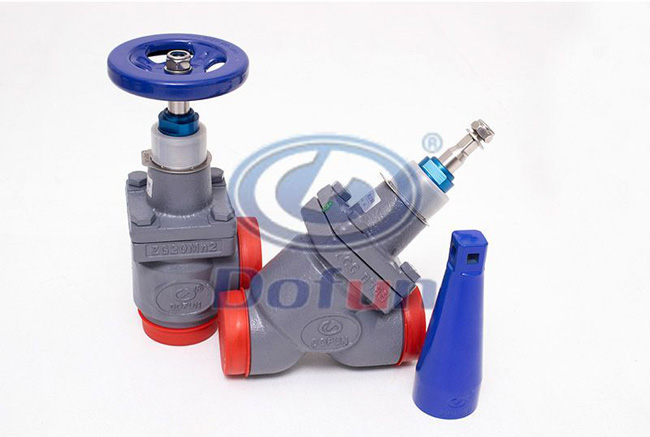The stop valve, also known as the cut-off valve, is a forced-sealing valve, which is a kind of cut-off valve. According to the connection mode, it is divided into three types: flange connection, threaded connection, and welding connection.
This type of shut-off valve is very suitable for shutting off or regulating and throttling. Since the opening or closing stroke of the valve stem of this type of valve is relatively short, and it has a very reliable cut-off function, and because the change of the valve seat port is in direct proportion to the stroke of the valve disc, it is very suitable for flow adjustment.
The shut-off valve is designed for low inlet and high outlet, the purpose is to make the flow resistance small and save effort when opening the valve. At the same time, when the valve is closed, the gasket between the valve casing and the valve cover and the packing around the valve stem will not be stressed, and will not be subjected to medium pressure and temperature for a long time, which can prolong the service life and reduce the probability of leakage. In addition, the packing can be replaced or added when the valve is closed for easy maintenance.
Many people think that the stop valve is low in and high out, but it is not. In general, the shut-off valve is a low inlet and high outlet.
1. High-pressure stop valve with a diameter greater than 100mm
Due to the poor sealing performance of large-diameter valves, when the shut-off valve is closed, the medium pressure acts on the valve flap to increase the sealing performance of the valve.
2. Two stop valves in series on the bypass pipeline, the second stop valve requires "high inlet and low outlet"
In order to ensure the tightness of the valve during an overhaul period, valves that frequently open and close are required to install two shut-off valves in series.

①Balance the front and backpressure of the main pipeline valve to make it easy to open and save effort and reduce the wear of the main pipeline valve;
②Small flow heating pipe during startup;
③On the main feedwater pipeline, control the feedwater flow to control the boiler pressure increase speed to perform the boiler water pressure test. According to the flow direction of the medium, the bypass stop valves are respectively the primary valve and the secondary valve. The primary valve and the secondary valve are closed during normal operation of the unit, and both are in direct contact with the medium. In order to prevent the packing between the casing and bonnet of the secondary valve and the packing around the valve stem from being affected by the medium and temperature for a long time, and the packing of the valve can be replaced during operation, the installation direction of the secondary valve is "high in and low out" ".
3. Vent the stop valve
The vent shut-off valve is only used in the boiler start-up and water supply process. The opening and closing frequency are small, but it often causes the loss of working fluid due to the lack of sealing. For this reason, some companies install this type of shut-off valve in order to improve the tightness.
4. Electromagnetic quick-break valve
The function of the electromagnetic quick cut valve is to close quickly and cut off the fuel supply quickly. The structure of the electromagnetic quick-break valve is similar to the structure of the shut-off valve. If the electromagnetic quick-break valve also enters from the lower part and flows out from the upper part, the force of the fuel acting on the lower part of the electromagnetic quick-break valve is very large, and the weight of the electromagnetic quick-break valve is much smaller than it. Therefore, if the working fluid enters the quick-break valve from the bottom, the torque generated by the heavy hammer is less than the torque generated by the fuel pressure, and the fuel cannot be cut off when the quick-break valve is activated, thus failing to achieve the expected purpose. If the working fluid enters from the upper part of the quick-break valve, once the quick-break valve is actuated, the pressure behind the valve decreases rapidly, and the force of the fuel acting on the lower part of the valve flap quickly drops to zero, and the force and weight of the fuel acting on the valve flap The force formed by the gravity of the lever.
Generally, it is difficult to close the valve if a low inlet and high outlet are used under large diameter and high-pressure conditions. If low inlet and high output are used under high pressure and large diameter conditions, the valve stem will be easily deformed and bent underwater pressure for a long time, which will affect the safety and sealing of the valve; If you choose the high and low position, the diameter of the valve stem can be smaller, and it will save a little cost for the manufacturers and users.
The above information is provided by the stop valve supplier.